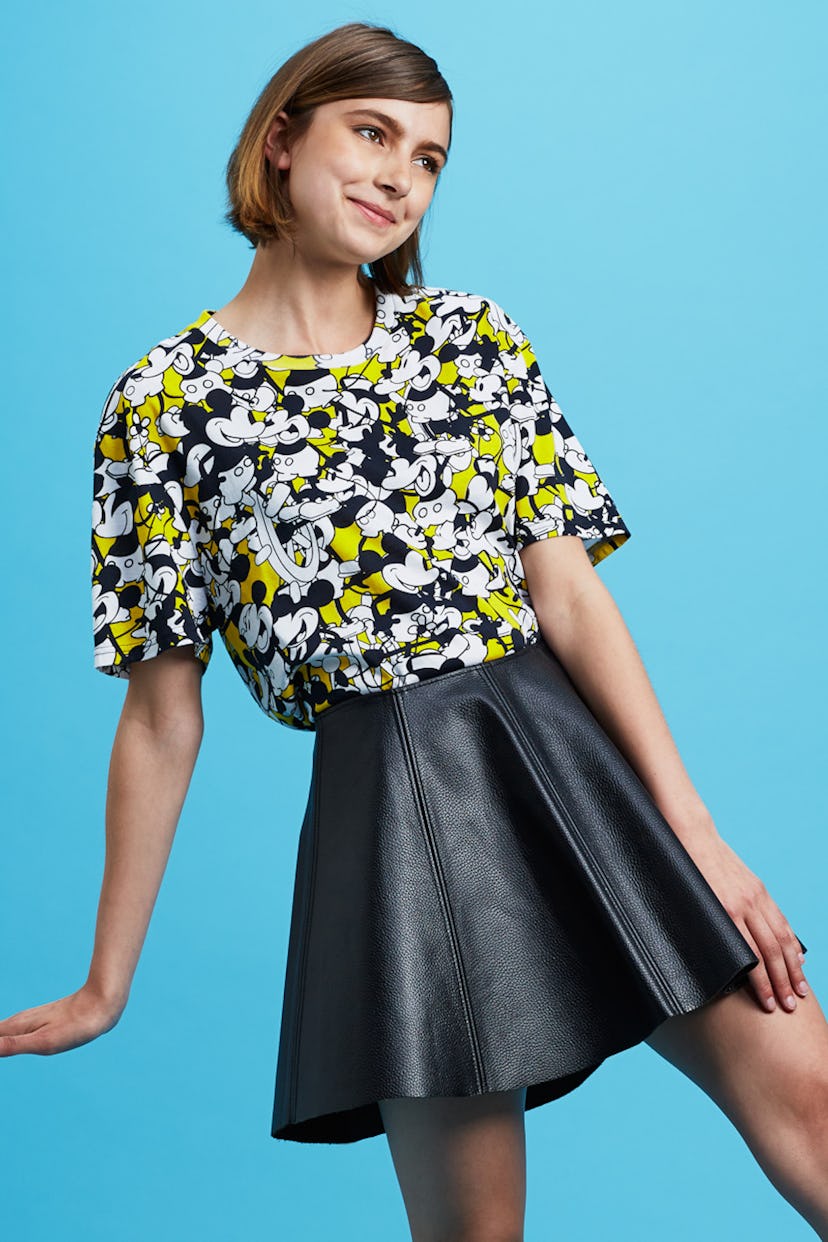Middle-age men are devoting hoursto crushing cartoon gumdropson their iPhones, grown-up readers are propelling young-adult books to the top of best-seller lists, and a shocking number of 30-somethings are still living at home with Mom and Dad. If society seems mired in some form of perpetual preadolescence, why should fashion be immune?
For fall, Miu Miu, a favorite label of starlets like Elle Fanning, presented a parade of pastels and rainbow hues, accented by purses that looked like book bags casually slung over the shoulder. At Moschino, Jeremy Scott referenced SpongeBob SquarePants on sweatshirts and backpacks—as Katy Perry, her hair tied in a polka-dot bow worthy of Minnie Mouse, watched from the front row. (It was Mickey who caught the fancy of Opening Ceremony designers Carol Lim and Humberto Leon, who launched clothing featuring the Disney mascot this past spring, which Pharrell Williams—the poster child for eternal youth—wore when performing on NBC’s talent show for adults, The Voice.) Rachel Antonoff, known for outfitting Lena Dunham (her brother Jack’s girlfriend), did the sort of little-girl dresses and layered jumpers that most of us last wore on kindergarten picture day. And at Chanel, the longtime mainstay of well-heeled ladies who lunch, Karl Lagerfeld swapped evening shoes for sneakers that could have been poached from junior-high gym lockers.
“In the 20th century, children were dressed like adults,” points out the fashion historian Patricia Mears, deputy director of the Museum at the Fashion Institute of Technology. For the past several decades, the opposite has been true, but “mostly in the street style of Japan, where women embrace baby-doll clothes as a form of social rebellion.” In the West, she says, “it’s rare for adults to look like children—but we’re in a very weird period.”
Some of the most blatant purveyors of regressive fashion are little more than children themselves. Eighteen-year-old designer Josh Reim’s sexually ambiguous fall men’s wear line, which was modeled on women, features ample overalls and jumpers made of polar fleece, corduroy, and denim that the Canadian decorated with sun and moon cartoons as well as multicolored foam lettering (i’m so free). Reim says it is “a reaction to the industrialization and over-modernization of our lives,” echoing Raf Simons, who, one season prior, dressed men in thigh-exposing onesies and pinafores inspired by what he referred to as “the freedom and the naturalness of children.”
“To me, it feels like conceptual art,” Mears says of such willful naïveté, which also characterizes the work of 30-year-old Jonathan Anderson. For his J.W. Anderson line, the British designer approaches the female form as if it were a Montessori puzzle, putting pieces together based on shape, rather than the semiotics and vintage references that dominate contemporary fashion. He takes technical fabrics that look like common household supplies—plastic wrap, place mats—and wraps them around the body the way a child might dress a doll. A rectangle of white cloth hangs from straps as fine as dental floss; a sweater, squared at the shoulders and hem, resembles a Crayola box with its bands of bold color.
The French label Jacquemus exudes a similar innocence. “I’m a—how do you say?—childish man,” confesses Simon Porte Jacquemus, its 24-year-old designer. His line is going on 5 now, and his latest collection, called La Femme Enfant, feels entirely age-appropriate. The clothes look like a preschooler’s drawings animated on a woman’s body. Circles are repeated on neoprene and boiled-wool garments that evoke Rei Kawakubo’s fall 2012 Comme des Garçons collection, which featured ultraflat-felt jackets and dresses straight out of a paper doll’s wardrobe. “It’s as if a child went around making everything into circles,” Jacquemus explains, adding that he hesitated at first to use neoprene since “it’s so fashion school” but ultimately couldn’t resist because the material reminds him of an infant’s foam play mat. What else would one expect from a man who named his label after his mother?
Photos: The Great Regression
Rachel Antonoff fall 2014. Courtesy of designer.
Josh Reim fall 2014. Photograph by Jetro Emilcar.
A look from the Mickey Mouse/Opening Ceremony capsule collection. Courtesy of Opening Ceremony.
Jacquemus fall 2014. Photo by CNP Montrose.
3.1 Phillip Lim fall 2014. Photo by CNP Montrose.
A spring 2014 look from J.W. Anderson. Photo by CNP Montrose.
Miu Miu fall 2014. Photo by CNP Montrose.
J.W. Anderson fall 2014. Photo by CNP Montrose.
Moschino fall 2014. Photo by CNP Montrose.
